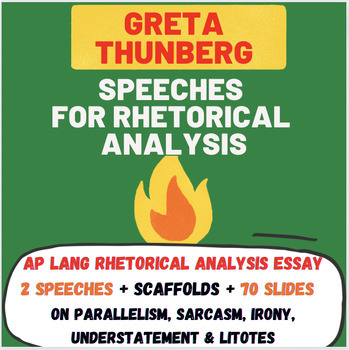Rhetorical Analysis Greta Thunberg Speeches Essay Organizer + Slides + AP Lang
- Google Drive™ folder

Description
Greta Thunberg offers rich analysis in understatement, sarcasm, irony, litotes, and parallelism. I've included 2 speeches that pair nicely: "The House is on Fire" and "The House is Still on Fire."
This material is visual, colorful, and includes lots of stems for rhetorical analysis writing.
What's included:
- 42-slides / lesson on parallelism and the overall structure of the Rhetorical Analysis essay
- 28-slides / lesson specific to rhetorical devices within Thunberg's speeches: understatement, sarcasm, irony, litotes.
- A detailed/scaffolded essay writing graphic organizer that guides students in developing thorough analysis and commentary with specific rhetorical analysis questions to get students to see the connection between writing choice (What / How / Why) it connects to the writer/speaker's message and produces a "so what" (Impact). The table organizer contains cues to get students to connect rhetorical choice to device to message and impact.
- 2 of Thunberg's speeches (House on Fire/ House Still on Fire) with guided close reading rounds and full speech texts.
- Link to all rhetorical analysis videos on my YouTube channel
- A handout reference sheet with the rhetorical devices of focus: understatement, sarcasm, irony, litotes.
- A digital interactive notebook version providing a visual engagement / annotation of the speech with links to "tone wheel" and "analysis stems"
All editable; digital or printed.
My students have had great outcomes using the guided writing organizer as a first step to the rhetorical analysis essay. Some of my students have used this material in college when writing essays. After a few times with the guide, students begin to see the connections required of this essay. This is an engaging speech and definitely draws students in. Two other resources that I find helpful are AP Lang Rhetorical Analysis Essay Reflection Tool and Rhetorical Device BIG Slide Deck.
Earn free TPT Credit!! Offer feedback by:
- Going to your "My Purchases" page to find the "Provide Feedback" button next to each purchase. Follow the link to offer a rating and leave a comment for the product.
- Each time you give Feedback, TPT awards you credit that you can use to lower the cost of future purchases.
- I value your feedback. I am continually improving and developing new resources based on feedback from the TPT community. Thank you!
Follow me by clicking the GREEN Star under my store name. Be the first to know about new products and promotions.
Follow on Instagram
Check out my blog with teaching strategies
Check out my YouTube Channel for video lessons
Check out these discourse resources to level up engagement in your classroom:
- Probing Questions Speed Dating
- Discourse Builder Discussion Roundtable / Close Reading Activity
- Questions Stems by Question Type One-pager
- Progressive Questioning PD Workshop
Check out these resources to engage students in Debate:
- Freedom v. Safety Debate
- Growth Mindset Debate
- Who Gets the Heart Debate
- Debate Template/Slides for In-person & Digital Debates
- Full Debate Bundle Adaptable for all levels/grades + ESL
Check out these Argument Writing Resources:
- AP Language Argument Essay Step-by-Step Writing Guide
- Rhetorical Claims & Appeals Bundle
- Argument Essay Slides
- Ethos, Pathos, Logos Slides
- AP Language Exam Overview & Study Guide with Links
- Argumentative Writing Folder
- Argument Writing Stems Handout with Counter-rebuttals
- “Unknown” AP Lang Argument Prompt Essay Organizer Kit
- “Overrated AP Lang Argument Prompt Essay Organizer Kit + Line of Reasoning
Check out these listings to boost your students’ engagement with Rhetorical Analysis
Read Like a Writer - Rhetorical Analysis Kit
AP Lang Rhetorical Analysis Essay Reflection Tool
Rhetorical Device BIG Slide Deck
Rhetorical Claims & Appeals Bundle
Preparing your students for AP / SAT Multiple Choice Exams? Drive home strategies through these resources that get students ENGAGED with test preparation.
- Multiple Choice READING Questions Video Guide + Scaffolded Notes
- Multiple Choice WRITING Questions Video Guide + Scaffolded Notes
- AP Lang Multiple Choice EXPERT LESSON Group Activity
- Multiple Choice WRITING Slides: Sentence Combining & Organization Questions
- Multiple Choice Strategies POWERPOINT - AP/SAT/PSAT/MCAS all subjects
- AP Lang Multiple Choice WRITING questions with VIDEO tutorials
- Multiple Choice READING questions GROUP SOLVE activity (AP Lang/SAT/PSAT)
- Multiple Choice Strategy Mini Cards
Follow my TPT store for sales & new products. Thank you for leaving a review!





